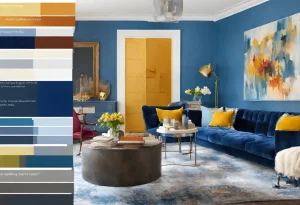Choosing the perfect color palette for your home is an important decision that can greatly impact the overall look and feel of your space. The right color scheme can create a cohesive and visually pleasing environment that reflects your personal style and enhances the functionality of each room. In this comprehensive guide, we will explore various tips and strategies to help you select the perfect color palette for your home.
1. Understand the Power of Color
Color is a powerful tool that can evoke different moods and emotions, so it’s crucial to understand the impact of different colors before choosing a color palette for your home. Each color has its own meaning and can create a specific atmosphere in a space. For example, warm colors like red, orange, and yellow can create a cozy and inviting ambiance, while cool colors like blue and green can promote a sense of calm and tranquility. Consider the purpose of each room and the mood you want to create before deciding on a color scheme.
2. Utilize a Color Wheel
A color wheel is a helpful tool that can assist you in creating a harmonious color palette for your home. It consists of primary colors (red, blue, and yellow), secondary colors (orange, green, and purple), and tertiary colors (mixtures of primary and secondary colors). Understanding the relationships between these colors can guide you in selecting complementary or analogous color schemes. Complementary colors are opposite each other on the color wheel and create a vibrant contrast, while analogous colors are adjacent to each other and offer a more harmonious and cohesive look.
3. Consider the Functionality of Each Space
Before choosing a color palette, it’s essential to consider the functionality of each space in your home. Different rooms serve different purposes, and the color scheme should align with the intended use of each area. For instance, a bedroom should promote relaxation and tranquility, so choosing soft and soothing colors like pastels or neutrals would be appropriate. On the other hand, a home office may benefit from energizing colors like vibrant blues or greens to enhance productivity and focus. Think about how you want each room to feel and select colors accordingly.
4. Draw Inspiration from Your Surroundings
Look to your surroundings for inspiration when choosing a color palette. Take a walk in nature or explore your favorite places to find colors that resonate with you. Pay attention to the colors of flowers, landscapes, or even artwork that catches your eye. By incorporating elements from your environment into your color scheme, you can create a harmonious connection between your home and the outside world. Additionally, consider the architectural features of your space, such as the flooring, cabinetry, or fixtures, and select colors that complement these existing elements.
5. Establish a Focal Point
Creating a focal point in each room can help guide your color palette decisions. A focal point can be a statement piece of furniture, a bold artwork, or even a unique architectural feature. By selecting colors that complement or enhance the focal point, you can create a cohesive and visually appealing space. For example, if you have a vibrant blue sofa as your focal point, you can choose complementary colors like warm yellows or neutrals to balance the overall look.
6. Consider the Lighting
Lighting plays a crucial role in how colors appear in a space. Natural light and artificial lighting can greatly impact the perception of color, so it’s vital to consider the lighting conditions in each room when choosing a color palette. Rooms with ample natural light can handle bolder and brighter colors, while spaces with limited natural light may benefit from lighter shades to create a sense of brightness and openness. It’s also important to test paint swatches under different lighting conditions to ensure the desired effect.
7. Create a Cohesive Flow
When selecting a color palette for your home, it’s important to create a cohesive flow between rooms. The colors used in one area should harmonize with the colors in adjacent spaces to create a sense of unity and continuity. This doesn’t mean every room needs to be the same color, but rather, there should be a common thread that ties the different spaces together. Consider using accent colors or varying shades of the same color throughout your home to maintain a cohesive and visually pleasing aesthetic.
8. Test Before Committing
Before committing to a specific color palette, it’s crucial to test the colors in your space. Paint small swatches on the walls and observe how they look throughout the day in different lighting conditions. Colors can appear differently on walls compared to paint swatches, so it’s important to see how they interact with the other elements in the room. Additionally, consider how the colors will work with your existing furniture, fabrics, and decor. Making informed decisions through testing will help you avoid costly mistakes and ensure you’re satisfied with the final result.
9. Seek Professional Advice
If you’re unsure about choosing the perfect color palette for your home or need expert guidance, don’t hesitate to seek professional advice. Interior designers or color consultants can provide valuable insights and help you create a customized color scheme that aligns with your style and preferences. They have the expertise to balance colors, textures, and patterns to create a harmonious and visually appealing space. Collaborating with a professional can save you time, ensure a cohesive design, and help you achieve the desired atmosphere in your home.
10. Trust Your Instincts
While there are guidelines and strategies for choosing a color palette, ultimately, trust your instincts and choose colors that resonate with you. Your home should reflect your personal style and make you feel comfortable and happy. If a specific color brings you joy or evokes a positive emotion, don’t be afraid to incorporate it into your design. Trusting your instincts will help create a space that feels authentic and unique to you.
Conclusion: How to Choosing the Perfect Color Palette for Your Home?
In conclusion, choosing the perfect color palette for your home is a personal and exciting process. By understanding the power of color, utilizing a color wheel, considering the functionality of each space, drawing inspiration from your surroundings, establishing focal points, considering lighting conditions, creating a cohesive flow, testing colors before committing, seeking professional advice when needed, and trusting your instincts, you can create a color palette that enhances the beauty and ambiance of your home. So go ahead, unleash your creativity, and transform your space with the perfect color palette that reflects your style and personality.
Read More Home Decor Hacks: Click Here




